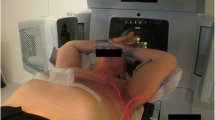Abstract
Purpose
To develop an objective and less invasive method for evaluating breath-hold status, and to investigate breath-hold reproducibility during voluntary breath-holding irradiation.
Materials and methods
We enrolled 20 patients who were treated using a voluntary breath-holding technique. Four or five sessions of cone beam computed tomography (CT) were performed during the radiotherapy session. An image of the lung with respiratory tract was extracted from the CT findings. The rigid registration of subsequent CT findings was completed using the first fraction CT findings. Next, subsequent CT images already subjected to rigid registration were deformed using the first CT images. We compared the differences in the subsequent CT images before and after the deformable registration.
Results
We were able to complete the method to evaluate breath-hold status without having to consider set-up uncertainty, manual processes, visual estimates, or excessive patient cooperation. Tumor dislocation was almost within 3 mm in all directions and deformation was much smaller than 30 % period of free breathing.
Conclusion
This method we have developed may have great potential for the objective verification of breath-hold reproducibility in a less invasive manner. This method assumed that the voluntary breath-hold status was reproducible enough at a clinically satisfactory level.





Similar content being viewed by others
References
Onishi H, Kawakami H, Marino K, Komiyama T, Kuriyama K, Araya M, et al. A simple respiratory indicator for irradiation during voluntary breath holding: a one-touch device without electronic materials. Radiology. 2010;255:917–23.
Tarohda TI, Ishiguro M, Hasegawa K, Kohda Y, Onishi H, Aoki T, et al. The management of tumor motions in the stereotactic irradiation to lung cancer under the use of Abches to control active breathing. Med Phys. 2011;38:4141–6.
Weiss E, Robertson SP, Mukhopadhyay N, Hugo GD. Tumor, lymph node, and lymph node-to-tumor displacements over a radiotherapy series: analysis of interfraction and intrafraction variations using active breathing control (ABC) in lung cancer. Int J Radiat Oncol Biol Phys. 2012;82:e639–45.
Panakis N, McNair HA, Christian JA, Mendes R, Symonds-Tayler JR, Knowles C, et al. Defining the margins in the radical radiotherapy of non-small cell lung cancer (NSCLC) with active breathing control (ABC) and the effect on physical lung parameters. Radiother Oncol. 2008;87:65–73.
Cheung PC, Sixel KE, Tirona R, Ung YC. Reproducibility of lung tumor position and reduction of lung mass within the planning target volume using active breathing control (ABC). Int J Radiat Oncol Biol Phys. 2003;57:1437–42.
Shen Y, Zhang H, Wang J, Zhong R, Jiang X, Xu Q, et al. Hypofractionated radiotherapy for lung tumors with online cone beam CT guidance and active breathing control. Radiat Oncol. 2010;5:19.
Mah D, Hanley J, Rosenzweig KE, Yorke E, Braban L, Ling CC, et al. Technical aspects of the deep inspiration breath-hold technique in the treatment of thoracic cancer. Int J Radiat Oncol Biol Phys. 2000;48:1175–85.
Sarrut D, Boldea V, Ayadi M, Badel JN, Ginestet C, Clippe S, et al. Nonrigid registration method to assess reproducibility of breath-holding with ABC in lung cancer. Int J Radiat Oncol Biol Phys. 2005;61:594–607.
Fukumitsu N, Hashimoto T, Okumura T, Mizumoto M, Tohno E, Fukuda K, et al. Investigation of the geometric accuracy of proton beam irradiation in the liver. Int J Radiat Oncol Biol Phys. 2012;82:826–33.
Gierga DP, Turcotte JC, Tong LW, Chen YL, DeLaney TF. Analysis of setup uncertainties for extremity sarcoma patients using surface imaging. Pract Radiat Oncol. 2014;4:261–6.
Uh J, Merchant TE, Li Y, Li X, Hua C. MRI-based treatment planning with pseudo CT generated through atlas registration. Med Phys. 2014;41:051711.
Abdelnour AF, Nehmeh SA, Pan T, Humm JL, Vernon P, Schoder H, et al. Phase and amplitude binning for 4D-CT imaging. Phys Med Biol. 2007;52:3515–29.
Kashani R, Hub M, Balter JM, Kessler ML, Dong L, Zhang L, et al. Objective assessment of deformable image registration in radiotherapy: a multi-institution study. Med Phys. 2008;35:5944–53.
Nie K, Chuang C, Kirby N, Braunstein S, Pouliot J. Site-specific deformable imaging registration algorithm selection using patient-based simulated deformations. Med Phys. 2013;40:041911.
Kirby N, Chuang C, Ueda U, Pouliot J. The need for application-based adaptation of deformable image registration. Med Phys. 2013;40:011702.
Pirozzi S, Piper J, Nelson A, Duchateau M, Verellen D, De Ridder M. A novel framework for user-intervened correction of deformable registration. Int J Radiat Oncol Biol Phys. 2013;87:S144.
Zhong H, Kim J, Chetty IJ. Analysis of deformable image registration accuracy using computational modeling. Med Phys. 2010;37:970–9.
Oborski MJ, Laymon CM, Qian Y, Lieberman FS, Nelson AD, Mountz JM. Challenges and approaches to quantitative therapy response assessment in glioblastoma multiforme using the novel apoptosis positron emission tomography tracer F-18 ML-10. Transl Oncol. 2014;7:111–9.
Yakoumakis N, Winey B, Killoran J, Mayo C, Niedermayr T, Panayiotakis G, et al. Using four-dimensional computed tomography images to optimize the internal target volume when using volume-modulated arc therapy to treat moving targets. J Appl Clin Med Phys. 2012;13:3850.
Conflict of interest
The authors declare that they have no conflict of interest.
Author information
Authors and Affiliations
Corresponding author
About this article
Cite this article
Fukumitsu, N., Hayashi, Y. Application of a deformable registration technique to investigate breath-hold reproducibility. Jpn J Radiol 32, 700–707 (2014). https://doi.org/10.1007/s11604-014-0369-y
Received:
Accepted:
Published:
Issue Date:
DOI: https://doi.org/10.1007/s11604-014-0369-y




